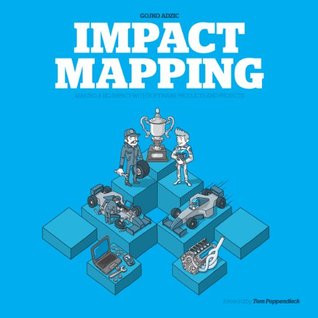More on this book
Community
Kindle Notes & Highlights
by
Gojko Adzic
Read between
February 8 - February 22, 2020
time between them for follow-up activities. Beware of measuring what is easy to track instead of what is valuable.
Ask: 'If we achieve the key targets for metrics with a completely different scope than planned, have we succeeded?' If the answer is 'No', go back to start: You don't the right metrics.
Is it realistic that the feature will contribute to the impact? Is the impact valid for the actor? Will the impact really contribute to achieve the goal?
a shorter journey to the key objectives. Don't criticise any ideas, just throw them on there. Use the existing skeleton map structure as an inspiration and ask the following questions:
What else could those guys do for us? Who else can help? How? Who can obstruct us?
previous ideas give people inspiration, but asking for new ideas makes people think harder.
To really push things to the limit here, you can try one of the collaborative games presented in the books Innovation Games [Hohmann06] and Gamestorming [Gray10].
Ask business sponsors to prioritise impacts, not deliverables (map level 3 and beyond). From my experience business users think more clearly about business activities and impacts than software features,
If you want to put more structure into this conversation, investigate the Kano and purpose-alignment models. The Kano model [Cohn06] provides a questionnaire to categorise features into
mandatory (must-have), linear (more is better) and exciters (small amount can dramatically increase satisfaction).
The purpose alignment model [Pixton09] breaks features down into categories of market-differentiating, parity (should be good enough), partner (non-mission-critical, buy som...
This highlight has been truncated due to consecutive passage length restrictions.
What is the simplest way to support this activity? What else could we do? If we're unsure about the assumption, what is the simplest way to test it? Could we test it without software? Could we start earning with a partly manual process?
If you can't define small experiments to test key assumptions, try user story mapping [Patton08b and Patton08c] or the hamburger method [Adzic12] to identify iterative delivery slices that could help you earn or learn sooner.
The first good approach is to list measurements as bullet points next to a particular map node or inside the node. The benefit of this approach is that it makes the distinction between measurements and actors or impacts quite clear, and keeps the map simple.
shows how plans that narrow attention to a single outcome, typically one of high commercial interest, have “an extraordinary power to increase yields”,
then the whole idea of supporting invitations with further functionality should be questioned. Treat such things as failed experiments if you can. Seriously think about removing functions that fail to meet your expectations from the software.
The overall vision map should capture desired longer-term effects and impacts on consumers. Deliverables on that map become product milestones, each with a separate lower-level impact map when its time comes.
Measure progress periodically against key milestone metrics. If the delivery fails to achieve key targets, it's time for a strategy rethink!


